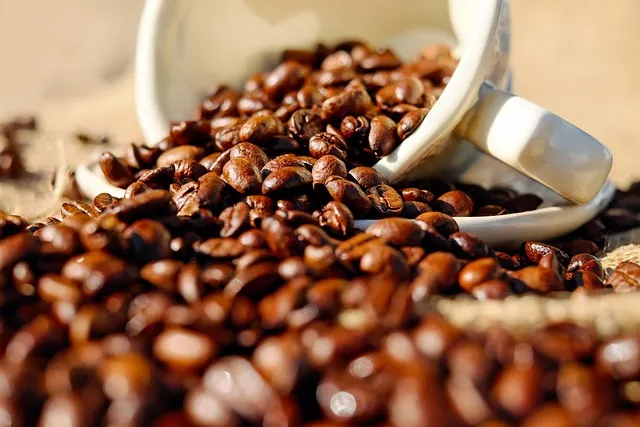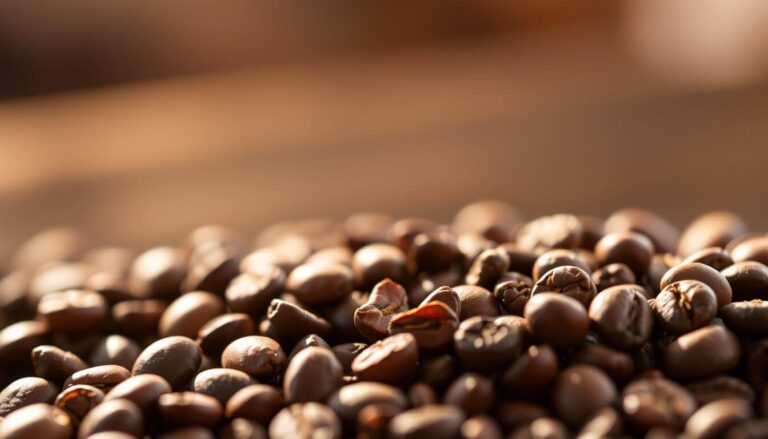9 Key Things to Know About Robusta Coffee
Discover the distinct characteristics of Robusta coffee, a staple in the world of coffee varieties. As a significant player in global coffee production, Robusta has garnered attention for its unique qualities.

Robusta coffee
With its robust flavor and high caffeine content, Robusta coffee has become a favorite among many coffee enthusiasts. This article will delve into the world of Robusta, exploring its production, uses, and what sets it apart from other coffee varieties.
Key Takeaways
- Understanding the significance of Robusta in global coffee production
- Exploring the unique qualities of Robusta coffee
- Discovering the uses of Robusta coffee in various blends
- Comparing Robusta to other coffee varieties
- The role of Robusta in the specialty coffee market
What Is Robusta Coffee?
Robusta coffee, known for its distinct flavor and higher caffeine content, is one of the two main commercial coffee species. It is scientifically classified as Coffea canephora, a plant that belongs to the family Rubiaceae. This coffee species is known for its hardiness and ease of cultivation, making it a popular choice among coffee producers.
Botanical Classification
Robusta coffee is botanically classified under the genus Coffea. Its full classification is as follows:
- Kingdom: Plantae
- Family: Rubiaceae
- Genus: Coffea
- Species: C. canephora
This classification highlights its close relation to other coffee species, particularly Coffea arabica, or Arabica coffee.
Key Characteristics
Robusta coffee is distinguished by several key characteristics:
- Flavor Profile: Robusta has a bolder, harsher flavor compared to Arabica, often described as earthy or rubbery.
- Caffeine Content: It contains a higher caffeine content, typically around 2-4%, compared to Arabica’s 0.8-1.2%.
- Disease Resistance: Robusta plants are more resistant to diseases and pests, making them easier to cultivate in various environments.
These characteristics make Robusta coffee a valuable component in espresso blends and instant coffee products, contributing to its widespread use in the coffee industry.
The History and Origins of Robusta Coffee
The story of Robusta coffee begins in the late 19th century, when it was first discovered in the Congo Basin. Initially known as Coffea canephora, Robusta was recognized for its robustness against diseases and pests, which made it an attractive crop for farmers.
Discovery and Early Cultivation
Robusta coffee was first identified in the Congo Basin in 1898. Its early cultivation was driven by the need for a coffee species that could withstand the challenges posed by diseases such as coffee leaf rust. The species was later cultivated in various parts of Africa and Asia due to its hardiness and ease of cultivation.
Spread Throughout the World
As the demand for coffee grew globally, Robusta’s cultivation spread to different regions. Vietnam became a major producer, leveraging the crop’s resilience and the country’s favorable climate. Other countries in Southeast Asia and Africa also began to cultivate Robusta, contributing to its global supply.
Historical Significance in Coffee Culture
Robusta has played a significant role in the coffee industry, particularly in the production of instant coffee and espresso blends. Its high caffeine content and robust flavor have made it a staple in many coffee blends. The table below highlights some key milestones in Robusta’s history.
| Year | Event | Region |
| 1898 | Discovery of Robusta | Congo Basin |
| Early 20th century | Initial Cultivation | Africa and Asia |
| Mid-20th century | Major Production | Vietnam and Southeast Asia |
The history of Robusta coffee is a testament to the dynamic nature of the coffee industry, with the species playing a crucial role in meeting global demand. Understanding its origins and evolution provides insights into the complexities of coffee production and trade.
Major Robusta Coffee Growing Regions
Robusta coffee is grown in various regions around the world, with certain countries standing out as major producers. The climate and soil conditions in these regions play a crucial role in the quality and quantity of Robusta coffee produced.
Vietnam: The Leading Producer
Vietnam is the world’s leading producer of Robusta coffee, accounting for a significant portion of global production. The country’s central highlands region, with its fertile soil and favorable climate, provides ideal conditions for Robusta cultivation.
Brazil and Other South American Regions
Brazil, while famous for its Arabica production, also grows a considerable amount of Robusta. Other South American countries, such as Colombia and Ecuador, are also involved in Robusta production, albeit on a smaller scale.
African Robusta Production
Several African countries, including Uganda, Ivory Coast, and Angola, are significant producers of Robusta coffee. The climate in these regions is generally conducive to Robusta cultivation, with high temperatures and well-defined wet and dry seasons.
Asian Growing Regions Beyond Vietnam
Apart from Vietnam, other Asian countries such as Indonesia and India are also notable producers of Robusta coffee. Indonesia’s islands, like Sumatra and Sulawesi, have conditions suitable for Robusta, while India’s Robusta production is mainly concentrated in the southern states.
The diversity in growing regions contributes to the varied flavor profiles and qualities of Robusta coffee available in the market. Understanding these regions is crucial for appreciating the complexities of Robusta coffee.
Understanding the Unique Qualities of Robusta Coffee
Understanding Robusta coffee requires exploring its unique flavor profile, bean structure, and disease resistance. Robusta coffee is known for its bold and straightforward flavor, which is often described as harsh and earthy. This distinctive taste is due to the higher concentration of caffeine and other compounds in the beans.
Distinctive Flavor Profile
The flavor profile of Robusta coffee is one of its most defining characteristics. It is often associated with a stronger, more bitter taste compared to Arabica. This is due to the higher caffeine content and the presence of other compounds that contribute to its distinctive earthy and nutty notes.
Bean Structure and Appearance
Robusta coffee beans are typically larger and more rounded than Arabica beans. They have a lighter color and a more uneven surface. The structure of the bean contributes to its higher yield and easier processing. A comparison of the physical characteristics of Robusta and Arabica beans is shown in the table below.
| Characteristics | Robusta | Arabica |
| Bean Size | Larger | Smaller |
| Bean Shape | More rounded | More elongated |
| Color | Lighter | Darker |
Natural Pest and Disease Resistance
Robusta coffee is known for its natural resistance to pests and diseases. This is largely due to its higher caffeine content, which acts as a natural deterrent to many pests. As a result, Robusta coffee requires fewer pesticides and other chemicals
Robusta Coffee’s Chemical Composition
Robusta coffee’s unique chemistry sets it apart from other coffee varieties, with several key components driving its characteristic taste and nutritional profile. The chemical composition of Robusta coffee is a complex mix that contributes to its flavor, potential health benefits, and its position in the coffee market.
Higher Caffeine Content Compared to Other Varieties
One of the most notable aspects of Robusta coffee’s chemical composition is its higher caffeine content compared to Arabica. This higher caffeine level not only affects the taste, making it more bitter, but also contributes to its use in espresso blends to provide a stronger kick.
Antioxidants and Other Beneficial Compounds
Robusta coffee is also rich in antioxidants and other beneficial compounds. These compounds play a crucial role in the potential health benefits associated with coffee consumption, such as reducing inflammation and improving heart health. The antioxidant profile of Robusta is somewhat different from that of Arabica, contributing to its unique nutritional profile.
Oil Content and Its Impact on Flavor
The oil content in Robusta coffee beans is generally lower than in Arabica beans. This lower oil content can impact the flavor, making Robusta taste less nuanced but more straightforward. The oil content also affects the coffee’s overall mouthfeel and the way it interacts with other ingredients in blends.
Robusta vs. Arabica: A Comprehensive Comparison
Robusta and Arabica are the two main coffee varieties that have garnered significant attention globally due to their distinct qualities. Understanding the differences between these two varieties is crucial for coffee consumers, producers, and enthusiasts alike.
Taste and Aroma Differences
The taste and aroma of Robusta and Arabica differ significantly. Arabica is known for its mild, nuanced flavor with notes of fruit and floral hints, while Robusta has a bolder, harsher taste with a grainy or nutty undertone. The difference in taste is largely due to the coffee’s chemical composition and the way it is processed.
Key differences in taste and aroma:
- Robusta: Bitter, harsh, with earthy or rubbery notes
- Arabica: Mild, fruity, with floral hints

Robusta vs Arabica coffee comparison
Growing Requirements and Conditions
Arabica and Robusta have different growing requirements. Arabica requires cooler temperatures, higher altitudes, and more shade, making it more challenging to cultivate. Robusta, on the other hand, is more robust and can thrive in a variety of conditions, including lower altitudes and higher temperatures.
The adaptability of Robusta makes it a more straightforward crop to manage for many farmers.
Price Points and Market Position
The price difference between Robusta and Arabica is significant, with Arabica generally being more expensive due to its more demanding growing conditions and higher production costs. Robusta is often used as a base for instant coffee and espresso blends due to its affordability and higher caffeine content.
“The price disparity between Arabica and Robusta reflects not just production costs, but also the perceived quality and market demand.”
Disease Resistance and Environmental Adaptability
Robusta is known for its natural resistance to pests and diseases, making it easier to grow without the use of pesticides. Arabica, being more sensitive, requires more care and often relies on pest management practices. This aspect makes Robusta more environmentally friendly in terms of cultivation.
Comparison of disease resistance:
| Coffee Variety | Disease Resistance |
| Robusta | Higher resistance |
| Arabica | Lower resistance |
Harvesting and Processing Methods for Robusta Coffee
To understand the unique qualities of Robusta coffee, it’s essential to examine the harvesting and processing methods used in its production. The quality and flavor profile of Robusta coffee are significantly influenced by how it is harvested and processed.
Traditional Harvesting Techniques
Robusta coffee is typically harvested using traditional methods, which involve selectively picking ripe coffee cherries. This labor-intensive process ensures that only the ripe cherries are chosen, which is crucial for the flavor and quality of the coffee.
Strip picking and hand-picking are two common traditional harvesting techniques. Strip picking involves removing all the cherries from the tree at once, while hand-picking involves selecting and picking individual ripe cherries.
Wet Processing vs. Dry Processing
The processing method used for Robusta coffee can significantly impact its flavor profile. There are two primary processing methods: wet processing and dry processing.
- Wet processing involves removing the outer skin and pulp of the coffee cherry before drying, resulting in a cleaner and more nuanced flavor.
- Dry processing, on the other hand, involves drying the coffee cherries in their fruit, which can result in a more robust and fruity flavor.
The choice between wet and dry processing depends on factors such as water availability and the desired flavor profile.
Modern Innovations in Robusta Processing
Recent advancements in technology have led to modern innovations in Robusta processing, aimed at improving efficiency and quality. These include the use of pulping machines and fermentation tanks to streamline the processing stage.
One of the significant innovations is the use of parchment drying, which helps to preserve the coffee’s natural flavors and aromas.
Impact of Processing on Final Flavor
The method used to process Robusta coffee has a direct impact on its final flavor. The level of fermentation, drying time, and the removal of the cherry’s pulp can all influence the coffee’s taste.
Understanding these factors is crucial for producers and roasters to achieve the desired flavor profile in their Robusta coffee.
Brewing the Perfect Cup of Robusta Coffee
With the right brewing methods, Robusta coffee can be transformed into a rich and satisfying beverage. The key to unlocking its full potential lies in understanding the nuances of the brewing process.
Recommended Brewing Methods
Robusta coffee can be brewed using various methods, each bringing out different aspects of its unique flavor profile. French press and espresso are particularly well-suited for Robusta, as they accentuate its bold and rich characteristics.
For a more nuanced flavor, pour-over and drip brewing methods can also be effective, allowing for a cleaner and more balanced extraction.

Robusta coffee brewing methods
Grind Size and Water Temperature Considerations
The grind size and water temperature are critical factors in brewing Robusta coffee. A finer grind is typically recommended for espresso, while a coarser grind is better suited for French press.
Water temperature should be between 195°F and 205°F for optimal extraction. Using water within this temperature range helps to bring out the full flavor potential of Robusta beans.
Blending Techniques with Other Coffee Varieties
Blending Robusta with other coffee varieties can create a more complex and balanced flavor profile. Arabica beans, in particular, are often blended with Robusta to add depth and smoothness.
The ratio of Robusta to other varieties can vary based on personal preference, but a common starting point is a blend of 20% Robusta and 80% Arabica.
| Blend Ratio | Flavor Profile |
| 100% Robusta | Bold, rich, and intense |
| 20% Robusta, 80% Arabica | Balanced, with a hint of Robusta’s boldness |
| 50% Robusta, 50% Arabica | A harmonious blend of both varieties’ characteristics |
Tips for Highlighting Robusta’s Best Qualities
To highlight the best qualities of Robusta coffee, it’s essential to use freshly roasted beans and to store them properly to preserve their flavor.
Experimenting with different brewing techniques and ratios can also help in finding the perfect balance that suits individual tastes.
Common Uses of Robusta in the Coffee Industry
The coffee industry utilizes Robusta in various applications, from traditional espresso blends to modern specialty coffee. This versatility stems from Robusta’s unique characteristics, such as its bold flavor and high caffeine content.
Espresso Blends and Italian Coffee Tradition
Robusta is a key component in many espresso blends, particularly in Italian coffee culture. It adds depth and crema to espresso shots, making it a staple in traditional Italian coffee.
- Enhances crema formation
- Adds depth to espresso flavor
- Widely used in Italian coffee culture
Instant Coffee Production
Robusta is also extensively used in instant coffee production due to its high yield and cost-effectiveness. The beans are often processed using methods that preserve their flavor and aroma.
Specialty Robusta and Third Wave Coffee Movement
The third wave coffee movement has brought attention to specialty Robusta, highlighting its potential for unique flavor profiles. Some roasters are now focusing on high-quality Robusta beans.
Commercial Applications Beyond Beverages
Beyond coffee beverages, Robusta is used in various commercial applications, including coffee-flavored products and cosmetics.
Health Benefits and Considerations of Robusta Consumption
With its robust flavor and energizing effects, Robusta coffee is a popular choice, but its health benefits and drawbacks need to be understood. As consumers become more health-conscious, understanding the implications of Robusta coffee consumption is crucial.
Potential Health Advantages
Robusta coffee contains antioxidants and other beneficial compounds that may contribute to overall health. Some studies suggest that moderate coffee consumption, including Robusta, may have protective effects against certain diseases.
Considerations for Caffeine-Sensitive Individuals
Robusta coffee’s higher caffeine content compared to Arabica can be a concern for those sensitive to caffeine. Individuals with caffeine sensitivity should be cautious with their consumption levels to avoid jitteriness, anxiety, or sleep disturbances.
Comparing Nutritional Profiles with Other Coffee Types
When comparing Robusta to Arabica, differences in nutritional content are notable. The table below summarizes key nutritional differences:
| Coffee Type | Caffeine Content | Antioxidant Level | Chlorogenic Acid |
| Robusta | Higher | Lower | Lower |
| Arabica | Lower | Higher | Higher |
Understanding these differences can help consumers make informed choices based on their health needs and preferences.
Conclusion: The Future of Robusta in the Global Coffee Market
As the global coffee market continues to evolve, Robusta coffee is poised to play a significant role in shaping the industry’s future. With its unique qualities, disease resistance, and higher yield, Robusta is an attractive option for producers and consumers alike.
The demand for Robusta coffee is influenced by various coffee trends, including the growing popularity of espresso blends and instant coffee. As consumers become more discerning, the quality of Robusta coffee is also improving, with many producers adopting innovative processing methods to enhance its flavor profile.
The future of Robusta coffee looks promising, driven by its potential to meet the demands of a growing global population and the need for sustainable coffee production. As the industry continues to adapt to changing consumer preferences and environmental concerns, Robusta coffee is likely to remain a vital component of the global coffee market.
FAQ
What is Robusta coffee?
Robusta coffee is a type of coffee bean known for its robust flavor and higher caffeine content compared to Arabica coffee. It is widely used in espresso blends and instant coffee production.
How does Robusta coffee taste?
Robusta coffee has a distinctive flavor profile that is often described as harsher and more bitter than Arabica. It can have notes of earthy, rubbery, or nutty flavors.
What are the main differences between Robusta and Arabica coffee?
The main differences lie in their taste, growing conditions, and price. Robusta is generally easier to grow, more disease-resistant, and has a higher caffeine content than Arabica.
Is Robusta coffee used in espresso?
Yes, Robusta coffee is often used in espresso blends to add depth and crema to the shot. It is a key ingredient in many traditional Italian espresso blends.
What are the health benefits of consuming Robusta coffee?
Robusta coffee, like other types of coffee, contains antioxidants and may have potential health benefits, including improved heart health and cognitive function. However, its higher caffeine content should be considered by those sensitive to caffeine.
How is Robusta coffee processed?
Robusta coffee can be processed using either wet or dry methods. The processing method can impact the flavor profile of the coffee, with wet processing typically resulting in a cleaner taste.
What is the future of Robusta coffee in the global market?
The future of Robusta coffee is influenced by trends in the coffee industry, including the demand for espresso and instant coffee. Its disease resistance and ease of cultivation make it an important crop for many farmers.
Can Robusta coffee be used for specialty coffee?
Yes, there is a growing interest in specialty Robusta coffee, with some producers focusing on improving the quality and flavor profile of Robusta beans through careful processing and roasting techniques.
How does the chemical composition of Robusta compare to Arabica?
Robusta coffee generally has a higher caffeine content and lower antioxidant levels compared to Arabica. The chemical composition affects the flavor and potential health benefits of the coffee.
What are the major Robusta coffee-producing countries?
Vietnam is the leading producer of Robusta coffee, followed by other countries in Southeast Asia, South America, and Africa. The climate and soil conditions in these regions are conducive to Robusta cultivation.




